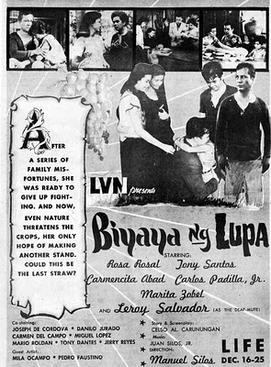Related Research Articles

Markova: Comfort Gay is a 2000 Filipino biographical-comedy, drama film written by Clodualdo Del Mundo Jr. and directed by Gil M. Portes. It was based loosely on the life of Walter Dempster Jr., the last surviving Filipino "comfort gay" from World War II. The film tells the story of his hardships during his childhood and his travail during the World War II Japanese occupation of the Philippines. The character was played by actor Dolphy, who played the adult Markova while two of his sons, Eric Quizon and Jeffrey Quizon, played the role of two younger Markovas in two more different phases of his life.

Ganito Kami Noon... Paano Kayo Ngayon? is a 1976 Philippine period drama film set in the end of Spanish colonization and the start of American colonization in the Philippines. Directed by Eddie Romero and written by Romero and Roy C. Iglesias, it stars Christopher de Leon and Gloria Diaz in the lead roles. The film was selected as the Philippine entry for the Best Foreign Language Film at the 49th Academy Awards, but was not accepted as a nominee.

Oro, Plata, Mata is a 1982 Philippine historical war drama film directed by Peque Gallaga, from a story by Peque Gallaga, Mario Taguiwalo, and Conchita Castillo and screenplay by José Javier Reyes. The film is considered to be Gallaga's most significant contribution to the Philippine cinema. Set in the Philippine island of Negros during World War II, it tells the story of how two hacendero families cope with the changes brought about by the war. In translation, the movie is also known either as "Gold, Silver, Bad Luck" or "Gold, Silver, Death."

Tatlong Taong Walang Diyos is a 1976 Filipino period film written and directed by Mario O'Hara that set in the province of Laguna during the Second World War. The film stars Nora Aunor as the barrio lass Rosario, Christopher De Leon as the Japanese-Filipino army officer Masugi, and Bembol Roco as the army guerilla member Crispin.

Blessings of the Land is a 1959 Filipino drama film directed by Manuel Silos. It was entered into the 10th Berlin International Film Festival. The film won Best Picture and Best Story from the Filipino Academy of Movie Arts and Sciences. In 1960, it was shown at the Asian Film Festival held in Tokyo. The story was written by Celso Al. Carunungan, while the screenplay was written by Carunungan together with Pablo Naval. The movie was produced by LVN Pictures.

Harvest Home is a 1995 Philippine melodrama film directed by Carlos Siguion-Reyna and produced by Armida Siguion-Reyna. The film stars Maricel Soriano and Snooky Serna as sisters reunited after the death of their father. Based on a story by Oscar Miranda, Bibeth Orteza, and Carlos Siguion-Reyna, it was written for the screen by Orteza.
ABS-CBN Film Restoration Project or also known as Sagip Pelikula, is a digital film restoration project of ABS-CBN Corporation in partnership with Central Digital Lab. The project is headed by Leo Katigbak of ABS-CBN Film Archives and Manet Dayrit of Central Digital Lab. The goal of the project is to digitally restore and remaster select Filipino films from the archives of ABS-CBN. Since the beginning of the project in 2011, the project has successfully digitized, restored, and remastered over one hundred Filipino films into a 1080p or 2K Digital Cinema Package format with a maximum resolution of 2048x1080 pixels at 24 frames per second. These films have been released through a wide array of platforms including limited theatrical runs, film festivals, free-to-air and cable television, DVDs, pay per view, and over-the-top content platforms such as iTunes. All of the restoration process are done by Central Digital Lab in the Philippines with the exception of Kakabakaba Ka Ba? and Tatlong Taong Walang Diyos which were commissioned by ABS-CBN to be restored abroad by L’Immagine Ritrovata in Bologna, Italy and was supervised by Davide Pozzi. All copyrights to the films restored and remastered are owned in perpetuity by ABS-CBN Corporation.
The Eugenio Lopez Junior Communications Center is the headquarters of ABS-CBN, and the media conglomerate of the same name and its subsidiaries. It is located at ABS-CBN Broadcasting Center Compound in Diliman, Quezon City, Philippines. The center occupies ten thousand (10,000) square meters of land area adjacent to the ABS-CBN Broadcasting Center and houses corporate offices, a studios, a three-level basement parking, a roof deck helipad, a film archive, a studio gallery, an exclusive executive dining restaurant, and garden. The center has a gross floor area of 101,608.32 square meters; almost seventy thousand (70,000) square meters of office space and over thirty thousand (30,000) square meters of parking space. The construction of the center, which costed 6 billion pesos, began in 1995, but was delayed due to the Asian Financial Crisis in 1997. It was opened in 2000, and was occupied gradually by ABS-CBN subsidiaries in the following years. It is a PEZA Special Economic Zone, designated as an IT center. It is named in honor of the late Eugenio Lopez Jr., the chairman emeritus of ABS-CBN. The dedication of the building was held on November 4, 2010, in a ceremony that was attended by the then-Philippine President Benigno Aquino III. ABS-CBN's Horizon PEZA IT Park, its soundstages, post-production and production facility of ABS-CBN is located at San Jose del Monte, Bulacan.

Hihintayin Kita sa Langit is a 1991 award-winning Filipino romantic drama film directed by Carlos Siguion-Reyna based on a screenplay by Raquel Villavicencio, and starring Richard Gomez and Dawn Zulueta. The film is a loose adaptation of Emily Brontë's 1847 novel Wuthering Heights. The film was restored by ABS-CBN Film Restoration and Central Digital Lab and was subsequently released in select theaters on February 27, 2017.

Hindi Nahahati ang Langit is a 1985 Filipino romantic drama film directed by Mike de Leon, story by Nerissa Cabral, and produced by Charo Santos-Concio and Simon Ongpin for Vanguard Films. Adapted into a written screenplay by Mia A. Concio from the Tagalog Klasiks serial of the same name by Nerissa G. Cabral. The film stars Christopher de Leon and Lorna Tolentino as step-siblings Noel and Melody and also stars Dina Bonnevie and Edu Manzano as Noel and Melody's respective spouses, Cynthia and Ronald.

Moral is a 1982 Filipino coming-of-age drama film directed by Marilou Diaz-Abaya and written by Ricky Lee. It is the second in a loose trilogy of feminist films by Diaz-Abaya and Lee which discusses women's issues, along with Brutal (1980) and Karnal (1983). Set in contemporary times in the Philippines, the film stars Lorna Tolentino, Gina Alajar, Sandy Andolong and Anna Marin as a group of friends and follows the course of their lives over the course of several years after they graduate from college. A "loosely structured, observational drama", the film discusses several topics that Diaz-Abaya and Lee saw as taboo at the time, such as abortion, rape, and gender inequality in the context of the changing morals of the time. This is Seven Star Productions' last feature film.

Badjao: The Sea Gypsies is a 1957 Philippine adventure drama film directed by National Artist Lamberto V. Avellana. The film was written by Rolf Bayer and stars Rosa Rosal, Tony Santos, Sr., Leroy Salvador, Vic Silayan, and Pedro Faustino. It tells a love story between Hassan, a Badjao man and Bala Amai, a Tausug woman whose differences were accepted by both sides but the Moro people attempted to destroy their lives.

The University of the Philippines Film Institute, also known as the UP Film Institute or UPFI, is a film school located in Quezon City, Philippines. It is attached to the UP College of Mass Communication and engages in theater and extension services, academics, and research related to cinema. The UPFI offers degree programs in the bachelor's and master's level.

Ibong Adarna is a 1941 Philippine film written and directed by Vicente Salumbides under LVN Pictures with Manuel Conde as the technical supervisor. It is a film adaptation of the epic poem of the same name. The film was originally released in black and white and is the first Philippine film with a color sequence.
Soltero is a 1984 drama film written by Bienvenido Noriega Jr. and directed by Pio de Castro III for the Experimental Cinema of the Philippines. The film stars Jay Ilagan, Rio Locsin, and Chanda Romero and it tells the life of a soltero living alone in his condominium apartment, working as an assistant manager at a bank, and how he manages his life with his family he loved and the past romances he had.
Cain and Abel is a 1982 Philippine action thriller drama film directed by Lino Brocka from a written story and screenplay by Ricardo "Ricky" Lee. The film's story was inspired by the Biblical story of two brothers, Christopher de Leon and Phillip Salvador respectively played the roles of Ellis and Lorenzo, the two brothers and sons of Senyora Pina, who have different views on each other. However, the sibling rivalry became violent and bloody due to the issue of inheritance of their family land and Senyora Pina's favoritism to her younger son. It also stars Carmi Martin as Zita, Ellis's fiancée from Manila; Cecille Castillo as Rina, the house helper, and Ellis's other woman; and Baby Delgado as Becky, Lorenzo's wife.
References
- ↑ Nocon, Ramon C (October 27, 2011). "Finally, a national film archive". Philippine Daily Inquirer. Retrieved February 21, 2022.
- ↑ San Diego Jr., Bayani (September 12, 2010). "Inside the Kapamilya film vaults". Philippine Daily Inquirer . Archived from the original on January 7, 2011. Retrieved October 29, 2012.
- ↑ del Mundo Jr., Clodualdo (January 26, 2011). "Continuing the dream for a national audio-visual archive". PinoyFilm.com. Archived from the original on November 24, 2012. Retrieved October 29, 2012.
- ↑ Atienza, Josephine. "Audio-visual archiving". National Commission for Culture and the Arts. Archived from the original on November 1, 2012. Retrieved October 29, 2012.
- ↑ Lago, Amanda T. (July 23, 2020). "After ABS-CBN shutdown, 'Sagip Pelikula' faces uncertain future". Rappler . Retrieved August 8, 2020.